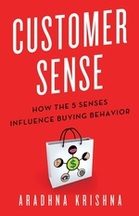
Professor Aradhna Krishna is considered one of the most influential scholars in sensory marketing. Consequently, she has given several keynote speeches for international companies and conferences. She has been the keynote speaker for academic and industry design conferences, sensory marketing conferences, scent marketing conferences, coffee conferences, and policy conferences.
Professor Krishna has taught BBA, MBA, PhD, and executive level courses on sensory marketing in the United States, Europe, and Asia. She also conducts innovation workshops with firms to understand and potentiate the sensory aspects of their products.
Topics
Sensory Marketing
Books:

KRISHNA, ARADHNA (ED.) (2009), SENSORY MARKETING: RESEARCH ON THE SENSUALITY OF CONSUMERS, ROUTLEDGE

KRISHNA, ARADHNA (2013), CUSTOMER SENSE: HOW THE 5 SENSES INFLUENCE BUYING BEHAVIOR, PALGRAVE MACMILLAN
Cases:
Note on Sensory Marketing: Shaping Consumer Perception and Behavior
March 1, 2019
How do our senses affect which products we like and don’t like? How can products be made more sensorially engaging? What should managers consider when devising sensory marketing strategies?
As companies are becoming more aware of consumers’ subconscious responses to products and services, they are relying less on traditional advertising and marketing and more on the products, themselves, to influence customers by stimulating an emotional response. This conceptual note defines sensory marketing, its theoretical foundations, and how it can best be used to shape consumer perception and behavior. It explores how deliberate sensory inputs can impact customers on a subconscious level by triggering positive emotional responses to products and brands through sight, sound, smell, taste and touch. The note also discusses advances in neuroscience and neuro-imaging techniques that have enabled more effective use of sensory marketing.
Uncharted Waters at Ventoso Ship Supply: A Sensory Marketing Dilemma
Mar 1, 2018
This is a three-part, disguised case series. In June 2009, Diana Zanzi was hired by Ventoso Ship Supply, an Italian sailboat manufacturer, to help them understand their boats’ puzzling selling patterns. Zanzi was informed that sales rates for two higher-end boat models were especially odd. Despite one’s superior technical specifications, speed, amenities, and overall value-for-money, their higher end models were hard to sell. However, a lower-quality boat was sold at an astonishing rate. Existing survey work conducted by the company only served to confirm the rational assumption that customers generally preferred more technically advanced sailboats; as such, the survey would not solve the mystery. Tasked with solving this mystery, Zanzi was given the contact information for Ventoso’s roster of potential customers and asked to conduct her own interviews to discover what could possibly explain customers’ preferences when acquiring sailboats. Zanzi was told that consumers may not be consciously aware of how they choose sailboats, and so she needed to figure out a good method to understand these unconscious preferences. In part A of the series, the reader is faced with the task of designing a test that might reveal buyers’ sailing-related thoughts. For instance, what should Zanzi ask consumers to understand their implicit and unconscious perceptions of the ideal sailboat? More importantly, the reader is invited to consider when and why such a tool is needed. In other words, what marketing technique should we use when consumers don’t seem to be fully aware of their decision process?
Pricing
Cases:
Pink Tax: Price Discrimination and Product Versioning Exercises
November 29, 2018
Authored by Aradhna Krishna, these exercises can be used in courses covering pricing strategy, segmentation, and price discrimination. They can also be used to complement the WDI Publishing Case “Pink Tax: Gender and other Price Discrimination Factors”. Diana Kelly is the brand manager for a company that has a new cream that gives consumers brighter, shinier nails. It will be sold in major retail outlets like Target, Walmart, CVS, and Walgreens. Kelly is given various segmentation schemes produced by consultancy teams to evaluate. Students are asked to evaluate the segmentation schemes and determine how the product should be versioned and priced.
Skudge Inc. (A-D): Exercises in Price Bundling
November 12, 2018
Skudge Inc. is a consulting firm specializing in food pricing with an emphasis on bundling. Students will follow Skudge founder Sid Kris Jorgenson as his firm determines what prices to charge to maximize profits for his clients. The exercises explain the difference between pure components, pure bundling, and mixed bundling models and how they can be applied to unique consumer segments with various reservation prices.
The exercise series is presented in four parts. Students should prepare Exercise A before class, and can complete Exercises B–D during the instruction period. Through this series of increasingly sophisticated exercises, students will gain a deep understanding of optimizing pricing and increasing profits through strategic bundling. Each consecutive exercise adds constraints to the bundling challenge, requiring students to construct increasingly complex algorithms.
Food For All: Cross-Cultural Corporate Social Responsibility
June 15, 2017
This three-part case, authored by Aradhna Krishna and Dana Muir, provides the opportunity to engage students in an examination of how cross-cultural considerations can affect managerial, legal, operational, and corporate social responsibility decision-making. The cases present two, non-profit organizations — one in the U.S. and one in India. Both organizations are focused on food redistribution but each faces different challenges based on cultural, legal, and logistical issues.
Cases A, B, and C are rolled out in a single class session. Students are given Cases A and B to read before class (including watching the video that accompanies Case B). Case C is handed out in class.
Katja’s Danish Bread: Making Some Dough – An Exercise in Price, Demand, Cost, and Capacity
June 1, 2017
Through this set of six exercises authored by Aradhna Krishna, students gain a deep understanding of the strong connection between price, demand, variable cost, and capacity. Each successive exercise builds up slowly in complexity as more information is added to the problem being considered. Mirroring real life, not all information is presented to students immediately — students must request the information they wish and may or may not get it, just as managers face in the real world. In the exercises, students take on the role of Katja, a small business owner intending to increase the profits of her business by maximizing sales while minimizing costs. Students work with price and demand schedules as well as fixed and variable costs as they make decisions for optimal price and capacity.
Exercise A is given to students before class, and then Exercises B-F are handed out sequentially during class. Exercises B-F are separate documents and are included as part of the teaching note so that the instructor can reveal further information and outcomes over time.
Pink Tax: Gender and Other Price Discrimination Factors
July 25, 2016
Diana Kelly is the brand manager for a company that has a new cream that gives consumers brighter, shinier nails. It will be sold in major retail outlets like Target, Walmart, CVS, and Walgreens. As Kelly conducts research to develop a pricing strategy, she discovers examples of price discrimination for products sold to women. In fact, women’s products were priced higher than men’s 42% of the time. Kelly considers having separate packaging for men and women and price the firm’s product higher for women. Will this help the company maximize profits? Is price discrimination ethical? In this case authored by Aradhna Krishna, students are asked to explore mechanisms for price discrimination and gender-based pricing.
Keeping it Clean During COVID-19: The Sanitizer Shortage
March 16, 2020
This case looks at the product shortages of N95 and N99 masks, hand sanitizers and wipes as a result of a new coronavirus, COVID-19. Students have to respond to the question: What are some alternate strategies to control product shortages and how do they impact consumers and disease control?
Connect With Me by Emailing
aradhna@umich.edu
